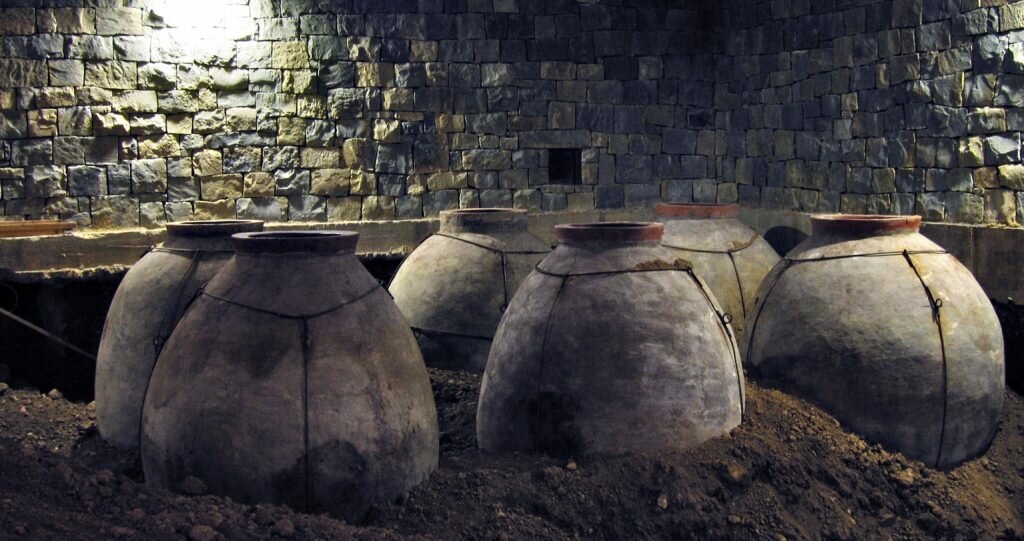What does it mean when an award deems you “most thought-provoking” among your peers? At the inaugural Wine Pinnacle Awards, held at Resorts World Sentosa last October, one of the award categories was Black Swan Of The Year, “highlighting challenging wines that have been able to break through on the international wine scene despite escaping traditional canons”. The winner of this highly controversial category? The Anfora Pinot Grigio Venezia Giulia IGT from Gravner, an iconic producer of the FriuliVenezia Giulia region in Italy.
Receiving the award with much generosity, Mateja Gravner remarked: “With neighbouring winemaker Radikon among the nominees, I see this prize as an award to [the] Oslavia winemaking community and the local group of producers who strongly believe in recovering old maceration techniques and native varieties. Oslavia has a lot to say to the world.”
Indeed, for the past few decades, the region has been at the forefront of refining and championing the age-old art of making skin-contact white wines. And this award — while still signifying a certain “outlier” connotation — is a stepping stone towards acknowledging the recent renaissance of orange wines, and getting widespread recognition for orange wine producers.

(Image: Gravner)
Call it what you will — orange wines, amber wines or skin-contact white wines — the style of wine that Oslavia neighbours Gravner and Radikon make (where white wine grapes are fermented and macerated on their skins with natural or ambient yeast and without temperature control) is hardly modern. In fact, it embraces traditional winemaking, just one of the few contentions with regards to the aforementioned wine award category.
The origins of orange winemaking date back almost 5,000 years to what is modernday Georgia, where people practised the ancient tradition of fermenting white wine grapes with their skins in kvevri (large clay amphoras) that are buried in the ground, with close to zero intervention from the winemaker. The vessels allow for slow and steady fermentation, give the wine freshness and help reflect terroir.
In the late 1990s, Josko Gravner wanted to improve the quality of his ribolla gialla (the indigenous white grape of Friuli) and determined that the best way to extract the true taste of the grapes was to ferment it on its skins. A fascination with this winemaking technique led him to Georgia, from where he ordered shipments of amphoras. Till today, all of Gravners’ wines are fermented in these amphoras.
-

(Image: Gravner) -

(Image: Gravner)
Around the same time, Stanko Radikon realised that his ribolla gialla wine was missing the entrancing aromas and flavours the grapes displayed when eaten straight off the vines. So he took a spare barrel and fermented some grapes for a week with their skins on — the results were revelatory.
Over the next few decades, he would experiment and fine-tune the length of skin-contact time. Thanks to the extended time on skins, orange wines are not only imbued with more colour, aromas and flavours, but also tannins, texture and structure. Their hues run the gamut from straw to rust, bright amber, even brown. Intensely aromatic and robustly flavoured, orange wines offer smoky, nutty and savoury scents and tastes, reminiscent of autumnal fruits like apricots and persimmon, spices and herbs. The wines also carry tannins, heavier textures and structure more akin to red wine than white, allowing for great pairings with a wide variety of food and giving them the potential to age for a very long time.

(Image: Gravner)

(Image: Gravner)
Despite initial scepticism and even rejection, Gravner and Radikon stuck to their guns and are now regarded as godfathers of the modern orange wine movement. Mateja, Josko’s daughter, says of Oslavia being the place of rebirth for orange wines: “[The native] ribolla’s juice is neutral, skin is its most aromatic and flavourful part, so if you separate the juice from the skin, you lose a big part of the grape’s taste. We make orange wine because the idea is to express what the grape variety can give you; in this way, we preserve and don’t waste anything from the grape: skin, stems and seeds are all part of the winemaking.”
And because orange wines spend time macerating with their skins, it is vital that the grapes are naturally perfect — of ideal ripeness and with no chemical taint. Sasa Radikon, who took over his late father Stanko’s winemaking role, expounds: “[When making orange wines] we are basically making an infusion of the skins; if there is anything bad in the skins, it’ll be brought into the wine. If we want longer maceration times, the tannins need to be right, and the grapes need to be ripe. Working the vineyard organically is imperative, making infusions with chemicals from sprays that remain on the grape skins does not make any sense. It’s dangerous.”
-

Sasa Radikon punches down the cap of skins that forms over fermenting white grapes. (Image: Radikon) -

Sasa Radikon punches down the cap of skins that forms over fermenting white grapes. (Image: Radikon) -

besides whites such as ribolla, Radikon has also released a merlot. (Image: Radikon)
Suffice to say, making a good orange wine starts with good vineyard management that employs organic principles. As such, the resurgence of orange wines goes hand in hand with the rise of the natural wine movement. “As people start caring more about food and the environment, wines need to be made in a healthy, sustainable way, by reducing environmental impact in the vineyards and minimising intervention during the winemaking,” shares Mateja.
The use of skin contact and low-intervention winemaking in white wines has become ubiquitous throughout the winemaking world, almost wherever you can find aromatic or semi-aromatic white grapes. Orange wine is being produced to great acclaim not only in Italy and Georgia, but also France, Spain, Austria, throughout Eastern Europe and in New World countries like Australia, Chile, US and even Japan. Its popularity and resonance proves it’s more than a fad.
Peruse the wine menus of top restaurants across the world and chances are, you’ll come across a section dedicated to orange or skin-contact white wines. In the event diners are not enlightened, “orange wine as a separate category makes sense,” states Sasa, who notes that a freshwhite wine style ribolla cannot be more different than a ribolla made in a orange wine style.
In the same vein, both Mateja and Sasa concur that they are looking forward to the day when orange wines have their own category in wine awards.

(Image: Radikon)

(Image: Radikon)
“It’s difficult to assess an orange wine in a white wine category; it’s like comparing a barolo to a soave,” bemoans Sasa. “But I do notice that orange wines are starting to be quoted even in traditional wine awards. It gives a chance to the two of us. Sure, it’s a particular category [within the Wine Pinnacle Awards], almost like they did not understand where to put us, but it’s a start.”
Mateja notes: “Until now, there has not been enough expertise to judge orange wines, and one has to have enough knowledge and be exposed to numerous orange wines in order to assess it.”
Hopefully, as the world collectively produces and consumes more skin-contact white wines, great orange wines will be recognised on their own merits.
This story first appeared in the March 2020 issue of A Magazine.
